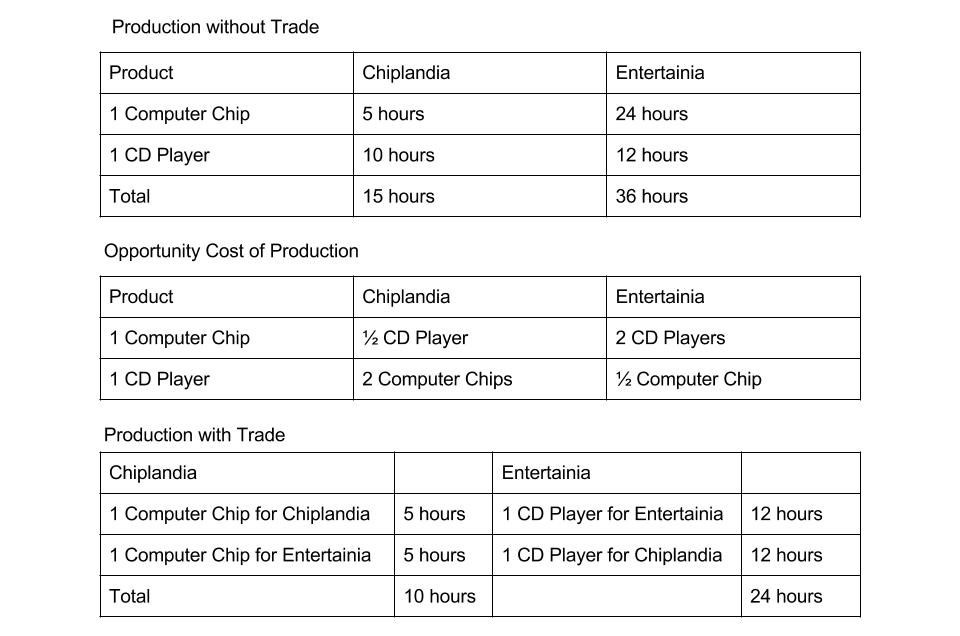If you’re diving into AP® Economics, whether Microeconomics or Macroeconomics, understanding comparative advantage definition is absolutely crucial. It’s a concept that not only unlocks key principles of economics but also frequently appears on AP® exams. Often confused with absolute advantage, comparative advantage is a distinct idea with profound implications for trade, specialization, and economic efficiency.
So, what exactly is comparative advantage, and how does it differ from absolute advantage? Why is grasping this concept so vital for your AP® Economics review, and potentially even relevant in understanding aspects of human geography related to resource allocation and trade patterns across different regions? Let’s break down these concepts, clarify their differences, and illustrate why they are fundamental in economics.
Absolute Advantage vs. Comparative Advantage: Clear Definitions
To start, let’s define each term precisely:
Absolute Advantage: This refers to the ability of an individual, firm, or country to produce more of a good or service than competitors, using the same amount of resources. Essentially, it’s about who is simply better at producing something.
Comparative Advantage: This focuses on opportunity cost. A person, firm, or country has a comparative advantage in producing a good or service if they can produce it at a lower opportunity cost than their competitors. Opportunity cost is what you give up to produce something else – your next best alternative.
Delving Deeper: Understanding Opportunity Cost
The key to differentiating between absolute and comparative advantage lies in understanding opportunity cost. It’s not just about who can produce more, but at what cost – in terms of forgone alternatives.
Let’s consider a simple scenario: Imagine two friends, Bryan and Rick, on a camping trip. They need two things: firewood and a tent.
Bryan can chop 20 pieces of firewood in an hour, while Rick can chop 10 pieces in the same time. In this case, Bryan has an absolute advantage in chopping firewood because he can produce more firewood than Rick in an hour.
Now, let’s add tent pitching to the equation. Suppose both Bryan and Rick can pitch a tent in one hour. Who has the comparative advantage in pitching tents? To determine this, we must consider opportunity costs.
For Bryan, spending an hour pitching a tent means he’s giving up the opportunity to chop 20 pieces of firewood. For Rick, spending an hour pitching a tent means he’s giving up the opportunity to chop 10 pieces of firewood.
Who gives up less firewood to pitch a tent? Rick does. Therefore, Rick has a lower opportunity cost of pitching a tent. His comparative advantage lies in pitching tents, even though Bryan is equally efficient at it in terms of time.
Why Comparative Advantage Is So Important in Economics
Why does comparative advantage hold such significance in economics, especially for your AP® Economics studies?
Comparative advantage is the fundamental principle that explains why trade occurs and why it benefits all parties involved. It demonstrates that even if one person or country is better at producing everything (has absolute advantage in everything), there are still gains from specialization and trade based on comparative advantage.
This principle extends from individuals to nations. Understanding comparative advantage helps explain:
- International Trade: Why countries trade with each other, even if one country is more productive overall. Countries specialize in producing goods and services where they have a comparative advantage and trade for others, leading to increased overall production and consumption. This concept is also relevant in human geography when analyzing global trade patterns and regional specialization based on resource availability and production efficiencies.
- Specialization: Why individuals and firms specialize in certain tasks or industries. By focusing on what they do relatively best (lowest opportunity cost), they can be more productive and efficient.
- Economic Efficiency: How resources can be allocated most efficiently to maximize output. Comparative advantage guides resource allocation towards activities where opportunity costs are minimized, leading to greater economic prosperity.
For your AP® Economics exams, mastering comparative advantage is crucial. You’ll encounter questions in both multiple-choice and free-response formats that require you to analyze scenarios, calculate opportunity costs, and determine comparative advantage.
Working Through a Detailed Example: Donuts and Cupcakes
Let’s tackle a more complex example, similar to what you might see on your AP® Macroeconomics or Microeconomics exam. Consider the following production possibilities table for John and Erica, showing the number of donuts and cupcakes each can produce in a day:
| Donuts | Cupcakes | |
|---|---|---|
| John | 200 | 100 |
| Erica | 150 | 50 |


First, let’s identify absolute advantage. John can produce more donuts (200 vs. 150) and more cupcakes (100 vs. 50) than Erica in a day. Therefore, John has an absolute advantage in producing both donuts and cupcakes.
Now, let’s determine comparative advantage by calculating opportunity costs.
John’s Opportunity Costs:
- Opportunity cost of 1 donut for John: 100 cupcakes / 200 donuts = 0.5 cupcakes per donut. (For every donut John makes, he gives up the chance to make half a cupcake).
- Opportunity cost of 1 cupcake for John: 200 donuts / 100 cupcakes = 2 donuts per cupcake. (For every cupcake John makes, he gives up the chance to make 2 donuts).
Erica’s Opportunity Costs:
- Opportunity cost of 1 donut for Erica: 50 cupcakes / 150 donuts = 1/3 cupcakes per donut (approximately 0.33 cupcakes per donut).
- Opportunity cost of 1 cupcake for Erica: 150 donuts / 50 cupcakes = 3 donuts per cupcake.
Comparing Opportunity Costs:
- For Donuts: Erica has a lower opportunity cost (1/3 cupcake) than John (0.5 cupcake). Therefore, Erica has a comparative advantage in producing donuts.
- For Cupcakes: John has a lower opportunity cost (2 donuts) than Erica (3 donuts). Therefore, John has a comparative advantage in producing cupcakes.
Even though John has an absolute advantage in both goods, comparative advantage is split. Erica should specialize in donuts, and John should specialize in cupcakes. Trade between them, based on these comparative advantages, will be beneficial for both.
Let’s imagine they specialize and trade. If Erica specializes in donuts and John in cupcakes, and they trade at a rate of 1 cupcake for 2.5 donuts.
- If Erica produces only donuts, she makes 150 donuts. If she trades 50 donuts to John, she gets 50/2.5 = 20 cupcakes. So Erica has 100 donuts and 20 cupcakes, better than her initial production of 150 donuts and 0 cupcakes if she only produced donuts and didn’t trade for cupcakes.
- If John produces only cupcakes, he makes 100 cupcakes. If he trades 20 cupcakes to Erica, he receives 20 * 2.5 = 50 donuts. So John has 80 cupcakes and 50 donuts, better than his initial production of 0 cupcakes and 50 donuts if he only produced cupcakes and traded for donuts.
Both are better off through specialization and trade based on comparative advantage.
Applying Comparative Advantage to Countries: Furnaces and Solar Panels
Let’s extend this concept to international trade, a key area in both AP® Macroeconomics and discussions related to global resource distribution in human geography. Consider two countries, Country X and Country Y, producing furnaces and solar panels with equal resources:
Country X: 6 Furnaces or 8 Solar Panels
Country Y: 6 Furnaces or 12 Solar Panels
Absolute Advantage: Country Y has an absolute advantage in solar panel production (12 vs. 8), while neither country has an absolute advantage in furnace production (both produce 6).
Comparative Advantage:
- Opportunity cost of 1 furnace for Country X: 8 solar panels / 6 furnaces = 1.33 solar panels.
- Opportunity cost of 1 solar panel for Country X: 6 furnaces / 8 solar panels = 0.75 furnaces.
- Opportunity cost of 1 furnace for Country Y: 12 solar panels / 6 furnaces = 2 solar panels.
- Opportunity cost of 1 solar panel for Country Y: 6 furnaces / 12 solar panels = 0.5 furnaces.
Comparative Advantage Determination:
- Furnaces: Country X has a lower opportunity cost (1.33 solar panels) than Country Y (2 solar panels). Country X has a comparative advantage in furnaces.
- Solar Panels: Country Y has a lower opportunity cost (0.5 furnaces) than Country X (0.75 furnaces). Country Y has a comparative advantage in solar panels.
Therefore, Country X should specialize in furnace production, and Country Y should specialize in solar panel production. Trade between them would be mutually beneficial.
For example, if the international trading price is 1 furnace for 1.5 solar panels.
- Country X specializes in furnaces: Produces 6 furnaces. Exports 2 furnaces, imports 2 * 1.5 = 3 solar panels. Ends up with 4 furnaces and 3 solar panels, better than if it produced domestically only (e.g., 3 furnaces and 4 solar panels, or any other combination on or inside its PPF).
- Country Y specializes in solar panels: Produces 12 solar panels. Exports 3 solar panels, imports 3/1.5 = 2 furnaces. Ends up with 2 furnaces and 9 solar panels, also better than domestic production alone.
Comparative Advantage and AP® Economics Exams
Expect to encounter questions about comparative advantage throughout your AP® Microeconomics and Macroeconomics exams. Free Response Questions (FRQs) often require you to:
- Calculate opportunity costs from production possibilities tables or scenarios.
- Determine absolute and comparative advantage.
- Analyze the gains from trade based on comparative advantage.
- Apply these concepts to both individual and national contexts.
Understanding the comparative advantage definition and its implications is not just about memorizing a definition; it’s about grasping a fundamental economic principle that explains trade, specialization, and efficiency.
Conclusion
The distinction between absolute advantage and comparative advantage is a cornerstone of economics. While absolute advantage is straightforward – who produces more – comparative advantage delves into opportunity cost – who sacrifices less. Comparative advantage is the driving force behind mutually beneficial trade, from individual exchanges to international commerce. Mastering this concept is essential for your AP® Economics success and provides valuable insights into how economies function, and even offers a framework for understanding global resource allocation and trade in a human geography context. By focusing on comparative advantage, you unlock a deeper understanding of economic interactions and the potential for prosperity through specialization and trade.
Looking for More AP® Economics Practice?
Explore our comprehensive resources on AP® Macroeconomics to deepen your understanding.
For targeted practice questions and to strengthen your skills, visit Albert.io. We offer a wealth of practice questions designed to help you master AP Economics.
Start your practice now here.
For educators seeking to enhance AP Macroeconomics outcomes for your students, discover more about our school licenses here.
